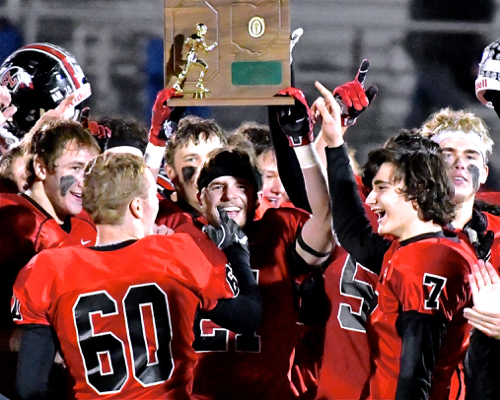In a twist of history, Piqua, Troy, Sidney, Greenville turns back the clock to a fondly remembered league affiliation called the Miami Valley League…while in two years the Cross County Conference follows suit for reasons all too familiar.
 In a matter of weeks a bit of nostalgia returns for fans of Piqua, Troy, Greenville, and Sidney football back in the day…the day of Barry Blackstone (Troy), Chuck Asher (Piqua), and Dave Haines (Sidney). All three coached in the days of the original Miami Valley League, which disbanded after the 1974-’75 season to become the Miami Central Conference, later to be absorbed into the now-defunct Greater Miami Valley Conference.
In a matter of weeks a bit of nostalgia returns for fans of Piqua, Troy, Greenville, and Sidney football back in the day…the day of Barry Blackstone (Troy), Chuck Asher (Piqua), and Dave Haines (Sidney). All three coached in the days of the original Miami Valley League, which disbanded after the 1974-’75 season to become the Miami Central Conference, later to be absorbed into the now-defunct Greater Miami Valley Conference.
That lasted for about a decade before the GWOC (Greater Western Ohio Conference) was formed in 2001, promising ease of scheduling, interesting crossover games, new rivalries, and increased attendance for football-hungry communities like Piqua and Sidney, the northern-most schools in the league. But none of that came to pass with the GWOC, except the part about easier scheduling. With three divisions and eighteen members you didn’t have to look far to find someone to play.
The new rivalries part never materialized. Traditional rivals like Troy, Piqua, and Sidney remained the same.
The interesting crossovers never really caught on…because fans in Piqua, Troy, and Sidney had no interest in teams from Springfield, Springboro and Lebanon. Travel to crossover games was brutal, and a trip to Lebanon through Friday evening Dayton traffic begged the question, “Why are we passing a half dozen other schools to play two counties away?”

The core teams of the ‘new’ MVL are all within twenty miles of each other on I-75 – Sidney and Butler (above), with Tipp, Troy, and Piqua.
Attendance was worse. Trotwood, Xenia, Springfield and even nearby Wayne brought very few fans to Greenville, Troy, Piqua and Sidney. And in the case of basketball, for years the issue of competitive balance left much to be desired. No one even remembers the last time Piqua or Troy beat Trotwood!
So at the end of last year it was decided that Greenville, Butler, Sidney, Piqua, and Tipp would bolt the GWOC to reform the Miami Valley League (MVL), joined by West Carrollton, Stebbins and Xenia – a ten-team conference affiliation. Most believed that it not only made sense (cents), but was a change long overdue. The rivalries up and down I-75 between Butler, Tipp, Troy, Piqua and Sidney are the ones that fans in those communities cared about. Greenville to the west will add interest, especially if they become more competitive in football.
“Things change,” Piqua athletic director Chip Hare said to me recently. “And now we’ll be able to have better competitive balance with like-size schools and like-size enrollments.”
No one can argue with that…just with why it took so long to figure it out.
Apparently it didn’t take that long over the winter for the western-most football schools in the Cross County Conference (Arcanum, Mississinawa, National Trail, Twin Valley South, Ansonia, Tri-County North, Tri-Village and Bradford – and non-football Franklin Monroe, Newton) to figure out that they no longer wanted to play schools like Covington, Bethel, Miami East, and football-only member Fort Loramie, from the Shelby County League. It was announced two months ago that those teams would seek more favorable league affiliation elsewhere, while Covington, Bethel and Miami East have since announced a new conference affiliation with West Milton, Northridge, Lehman, Troy Christian, and Riverside.
 Some have been tight-lipped about it, as the western schools chose to take matters in their own hands.
Some have been tight-lipped about it, as the western schools chose to take matters in their own hands.
“There really wasn’t any choice,” said one community member, off the record. “We weren’t going to compete with Covington and Miami East, and especially Fort Loramie. And if we were going to keep football alive we had to find a better situation.”
This caught Covington, East and Bethel by surprise, of course, although Covington was invited to join the majority…as it amounted to what Baltimore Colts owner Robert Irsay did in the middle of the night back in 1984, when he loaded up moving vans and moved the team from Baltimore to Indianapolis.
“It isn’t about them leaving,” said Miami East athletic director Scott Donaldson at the time. “It’s the way they went about it. No one seemed willing to sit down and talk.”

Some worried that Fort Loramie had gotten too good, too fast. “I think they though we were the 1985 Chicago Bears,” said one school official. “But we just had a good group of kids go through. Things happen in cycles.”
But what was there to talk about? Said another community member. “I don’t think anything was going to change the way things were going.”
Point taken, Arcanum last beat Covington in football in the fall of 2004.
But they’ll have to, at least for another two years until the two new leagues come to fruition.
One who did talk was Fort Loramie principal Kreg Hollenbacher, whose Redskins blew through the Cross County Conference in football the past two years, losing just once, to Miami East, in their short tenure as a conference member.
 “I think people think we’re the 1985 Chicago Bears,” Hollebacher said in February. “But in reality we’ve just had a good group of kids go through in the past two years. These things happen in cycles and we might not see that kind of cycle again for years. It was a matter of proximity between schools (the league was far-flung across Miami, Shelby, Darke and Preble counties) and competitive balance.”
“I think people think we’re the 1985 Chicago Bears,” Hollebacher said in February. “But in reality we’ve just had a good group of kids go through in the past two years. These things happen in cycles and we might not see that kind of cycle again for years. It was a matter of proximity between schools (the league was far-flung across Miami, Shelby, Darke and Preble counties) and competitive balance.”
But it wasn’t just football that flummoxed schools like Arcanum, Ansonia, TVS and Mississinawa. Miami East has dominated all the Cross County schools in volleyball.

Miami East was volleyball dominate in the CCC, with players like Jonni Parker (above).
“I don’t know if they’ve ever lost a conference volleyball game,” said Arcanum superintendent John Stephens back in March. The Vikings won back-to-back state titles in 2011 and ’12.
The irony? This is nothing new – what goes around comes around. For once upon a time Covington was in a similar scenario, having a hard time winning football games in the Southwest Rivers Conference against the likes of Tipp City and Versailles. The Buccs left for the more competitive appeal of the Cross County Conference in 1991, a league formed for schools of similar size and numbers in football.
Miami East, likewise, was having a hard time winning in football during its short tenure in the early 2000’s as a member of the Central Buckeye Conference. Looking to find a better competitive fit, the Vikings applied for membership in the CCC more than a decade ago.
Which is all fine. Because, if the end result is what’s best for kids it’s hard to maintain a program if you feel you’re losing ground, and no one argues that the climate for football in some small schools has never been tougher to maintain and afford. While some schools add that it’s not all about football, football is still the biggest chunk of their athletic budget, and in most cases the centerpiece of their athletic profile. The only solution it seemed in this case…was to start fresh. Form a league of their own.
 Ironically, the team left out of all this is Fort Loramie, which was not included in the new conference-to-be-named-later with Covington, East, and Bethel. And, there’s no mention of what’s to become of Bradford football, a long-time member of the CCC that frankly has fought just to keep the sport alive. Last fall they played with less than twenty kids.
Ironically, the team left out of all this is Fort Loramie, which was not included in the new conference-to-be-named-later with Covington, East, and Bethel. And, there’s no mention of what’s to become of Bradford football, a long-time member of the CCC that frankly has fought just to keep the sport alive. Last fall they played with less than twenty kids.
So, what goes around does comes around, especially if you’re old enough to remember…even for schools that never saw it coming.
“Things are cyclical,” GWOC commissioner Eric Spahr said to the Dayton Daily News this spring, echoing Kreg Hollenbacher’s words. “This happens in conferences every 15-20 years. It’s part of high school athletics. Demographics change and communities change in terms of size and enrollment and things of that nature.”
And things like dollars…and sense!

With its own tradition of football and two playoff appearances in '86 and 2002, Arcanum and eight other teams from the Cross County Conference have gone looking for more favorable competitive balance. (Press Pros Feature Photos)

